Salby M.L. Fundamentals of Atmospheric Physics
Подождите немного. Документ загружается.

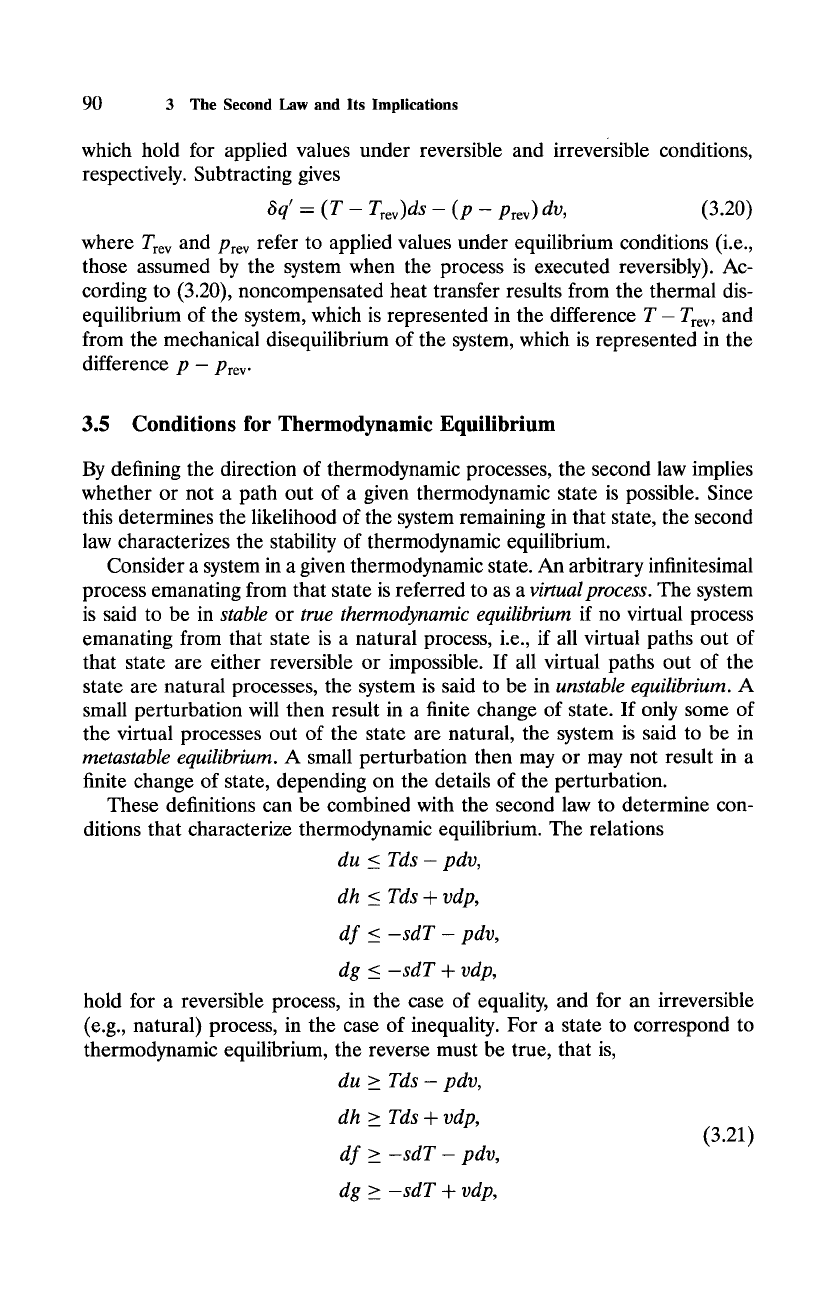
90
3 The Second Law and Its Implications
which hold for applied values under reversible and irreversible conditions,
respectively. Subtracting gives
~qt __ (T - Trev)ds - (p -
Prev)dl), (3.20)
where Trev and Prev refer to applied values under equilibrium conditions (i.e.,
those assumed by the system when the process is executed reversibly). Ac-
cording to (3.20), noncompensated heat transfer results from the thermal dis-
equilibrium of the system, which is represented in the difference T- Tre v, and
from the mechanical disequilibrium of the system, which is represented in the
difference p- Prev"
3.5 Conditions for Thermodynamic Equilibrium
By defining the direction of thermodynamic processes, the second law implies
whether or not a path out of a given thermodynamic state is possible. Since
this determines the likelihood of the system remaining in that state, the second
law characterizes the stability of thermodynamic equilibrium.
Consider a system in a given thermodynamic state. An arbitrary infinitesimal
process emanating from that state is referred to as a
virtualprocess. The
system
is said to be in
stable
or
true thermodynamic equilibrium
if no virtual process
emanating from that state is a natural process, i.e., if all virtual paths out of
that state are either reversible or impossible. If all virtual paths out of the
state are natural processes, the system is said to be in
unstable equilibrium. A
small perturbation will then result in a finite change of state. If only some of
the virtual processes out of the state are natural, the system is said to be in
metastable equilibrium.
A small perturbation then may or may not result in a
finite change of state, depending on the details of the perturbation.
These definitions can be combined with the second law to determine con-
ditions that characterize thermodynamic equilibrium. The relations
du < Tds- pdv,
dh < Tds + vdp,
df <_ -sdT- pdv,
dg <_ -sdT + vdp,
hold for a reversible process, in the case of equality, and for an irreversible
(e.g., natural) process, in the case of inequality. For a state to correspond to
thermodynamic equilibrium, the reverse must be true, that is,
du > Tds- pdv,
dh >_ Tds + vdp,
df > -sdT- pdv,
(3.21)
dg > -sdT + vdp,
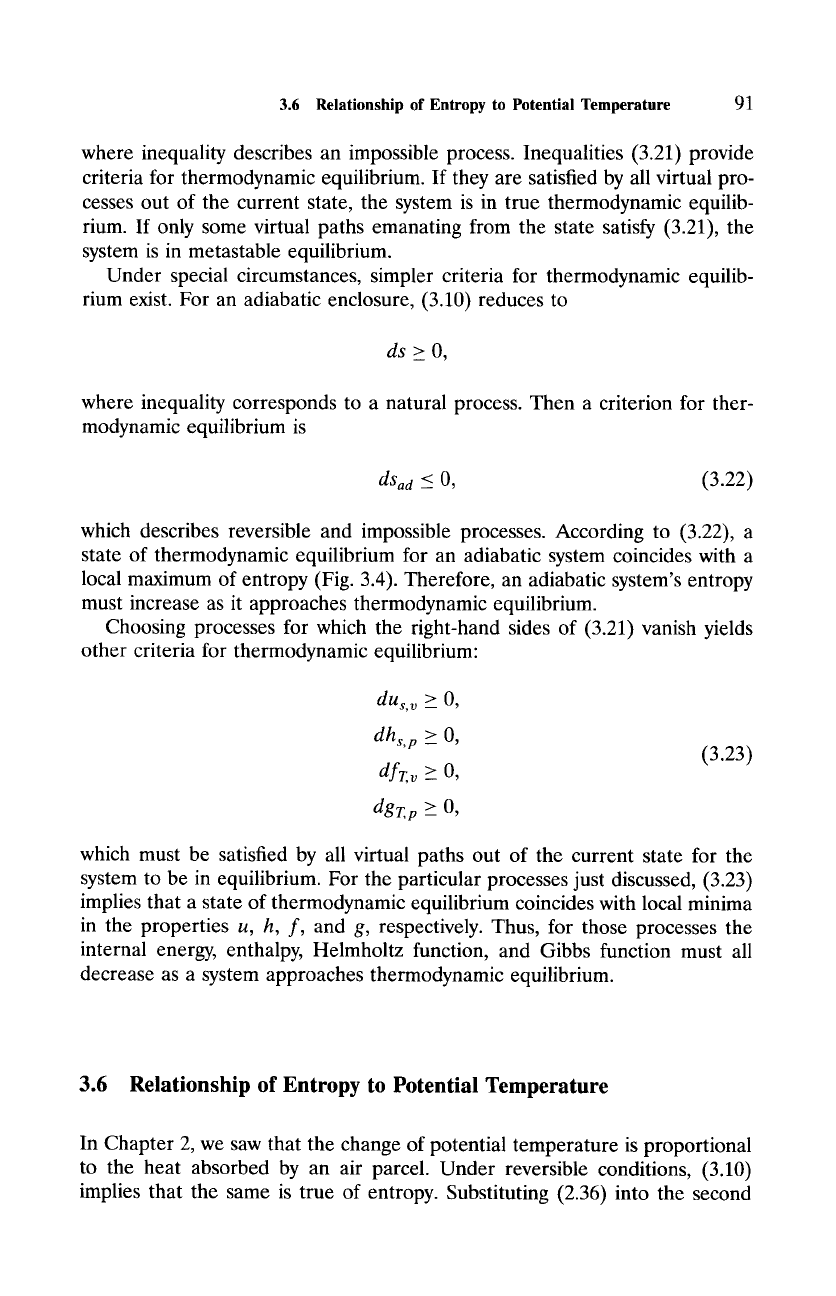
3.6 Relationship of
Entropy to Potential Temperature
91
where inequality describes an impossible process. Inequalities (3.21) provide
criteria for thermodynamic equilibrium. If they are satisfied by all virtual pro-
cesses out of the current state, the system is in true thermodynamic equilib-
rium. If only some virtual paths emanating from the state satisfy (3.21), the
system is in metastable equilibrium.
Under special circumstances, simpler criteria for thermodynamic equilib-
rium exist. For an adiabatic enclosure, (3.10) reduces to
ds>_O,
where inequality corresponds to a natural process. Then a criterion for ther-
modynamic equilibrium is
dSad <
O,
(3.22)
which describes reversible and impossible processes. According to (3.22), a
state of thermodynamic equilibrium for an adiabatic system coincides with a
local maximum of entropy (Fig. 3.4). Therefore, an adiabatic system's entropy
must increase as it approaches thermodynamic equilibrium.
Choosing processes for which the right-hand sides of (3.21) vanish yields
other criteria for thermodynamic equilibrium:
dus, v > O,
dhs, p > O,
df ~,v > O,
dg~,p >_0,
(3.23)
which must be satisfied by all virtual paths out of the current state for the
system to be in equilibrium. For the particular processes just discussed, (3.23)
implies that a state of thermodynamic equilibrium coincides with local minima
in the properties u, h, f, and g, respectively. Thus, for those processes the
internal energy, enthalpy, Helmholtz function, and Gibbs function must all
decrease as a system approaches thermodynamic equilibrium.
3.6 Relationship of Entropy to Potential Temperature
In Chapter 2, we saw that the change of potential temperature is proportional
to the heat absorbed by an air parcel. Under reversible conditions, (3.10)
implies that the same is true of entropy. Substituting (2.36) into the second
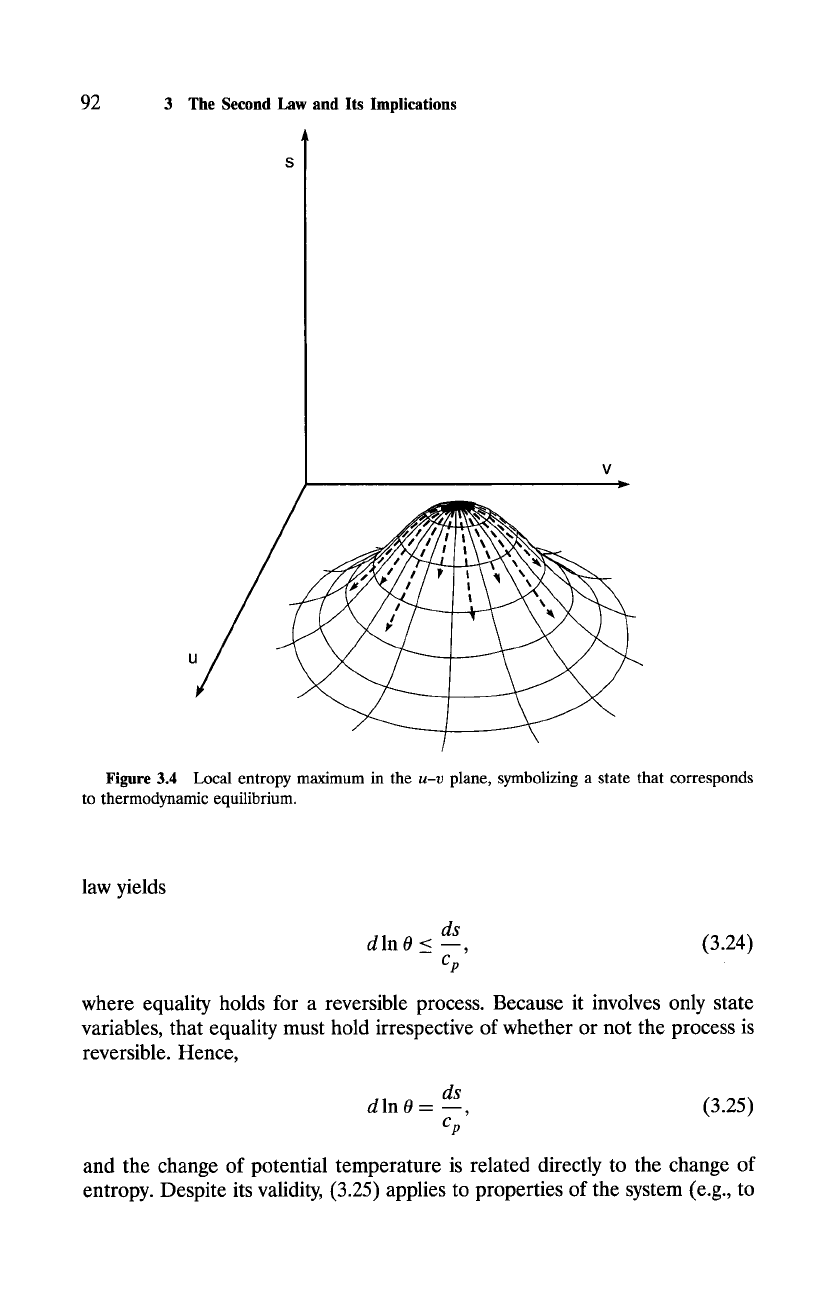
92
3 The Second Law and Its Implications
v
H
/
Figure 3.4 Local entropy
maximum in the
u-v
plane, symbolizing a state that corresponds
to thermodynamic
equilibrium.
law yields
ds
din 0
_< ~,
(3.24)
Cp
where equality holds for a reversible process. Because it involves only state
variables, that equality must hold irrespective of whether or not the process is
reversible. Hence,
ds
d In 0 -
~, (3.25)
Cp
and the change of potential temperature is related directly to the change of
entropy. Despite its validity, (3.25) applies to properties of the system (e.g., to
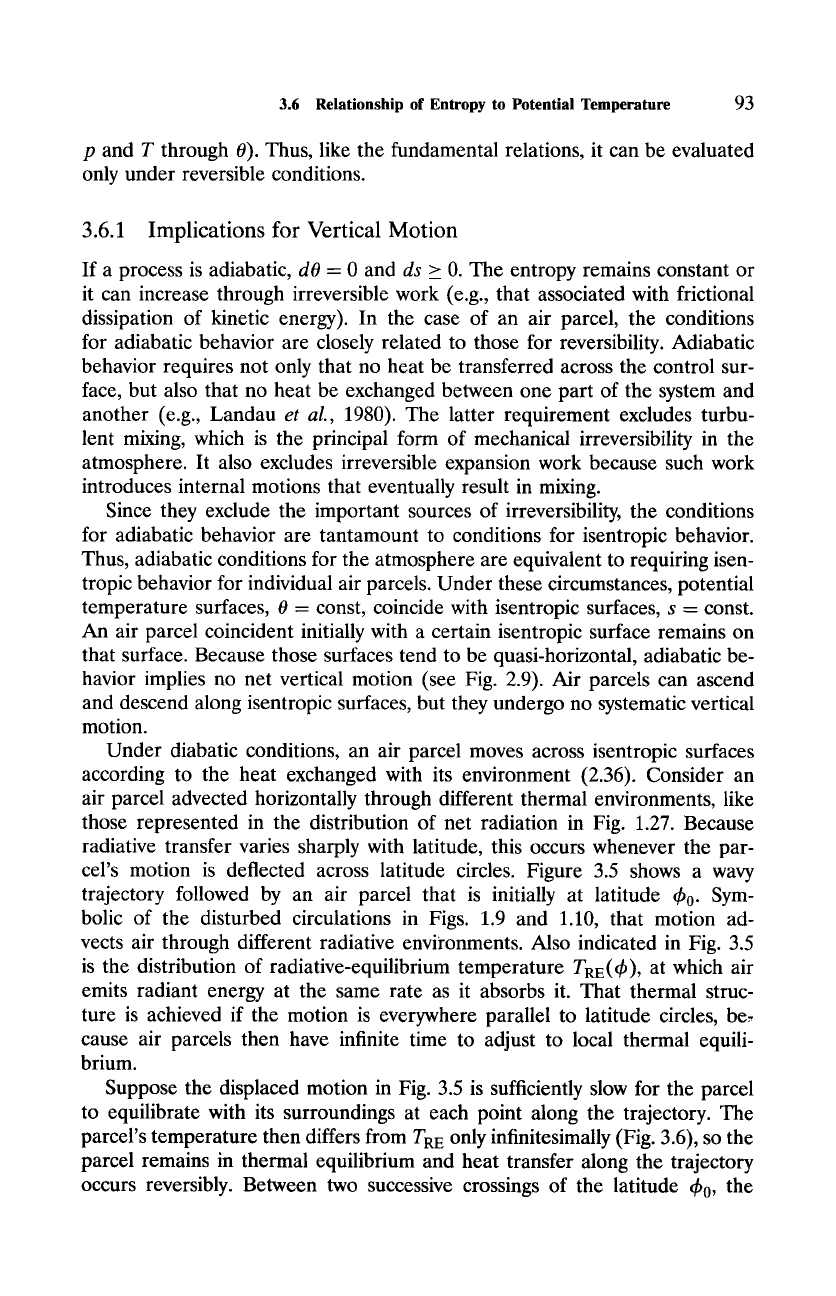
3.6 Relationship of Entropy to Potential Temperature
93
p and T through 0). Thus, like the fundamental relations, it can be evaluated
only under reversible conditions.
3.6.1 Implications for Vertical Motion
If a process is adiabatic,
dO
= 0 and
ds >_ O.
The entropy remains constant or
it can increase through irreversible work (e.g., that associated with frictional
dissipation of kinetic energy). In the case of an air parcel, the conditions
for adiabatic behavior are closely related to those for reversibility. Adiabatic
behavior requires not only that no heat be transferred across the control sur-
face, but also that no heat be exchanged between one part of the system and
another (e.g., Landau
et al.,
1980). The latter requirement excludes turbu-
lent mixing, which is the principal form of mechanical irreversibility in the
atmosphere. It also excludes irreversible expansion work because such work
introduces internal motions that eventually result in mixing.
Since they exclude the important sources of irreversibility, the conditions
for adiabatic behavior are tantamount to conditions for isentropic behavior.
Thus, adiabatic conditions for the atmosphere are equivalent to requiring isen-
tropic behavior for individual air parcels. Under these circumstances, potential
temperature surfaces, 0 = const, coincide with isentropic surfaces, s = const.
An air parcel coincident initially with a certain isentropic surface remains on
that surface. Because those surfaces tend to be quasi-horizontal, adiabatic be-
havior implies no net vertical motion (see Fig. 2.9). Air parcels can ascend
and descend along isentropic surfaces, but they undergo no systematic vertical
motion.
Under diabatic conditions, an air parcel moves across isentropic surfaces
according to the heat exchanged with its environment (2.36). Consider an
air parcel advected horizontally through different thermal environments, like
those represented in the distribution of net radiation in Fig. 1.27. Because
radiative transfer varies sharply with latitude, this occurs whenever the par-
cel's motion is deflected across latitude circles. Figure 3.5 shows a wavy
trajectory followed by an air parcel that is initially at latitude ~b 0. Sym-
bolic of the disturbed circulations in Figs. 1.9 and 1.10, that motion ad-
vects air through different radiative envil'onments. Also indicated in Fig. 3.5
is the distribution of radiative-equilibrium temperature TRz(~b), at which air
emits radiant energy at the same rate as it absorbs it. That thermal struc-
ture is achieved if the motion is everywhere parallel to latitude circles, be,
cause air parcels then have infinite time to adjust to local thermal equili-
brium.
Suppose the displaced motion in Fig. 3.5 is sufficiently slow for the parcel
to equilibrate with its surroundings at each point along the trajectory. The
parcel's temperature then differs from TRZ only infinitesimally (Fig. 3.6), so the
parcel remains in thermal equilibrium and heat transfer along the trajectory
occurs reversibly. Between two successive crossings of the latitude ~b 0, the
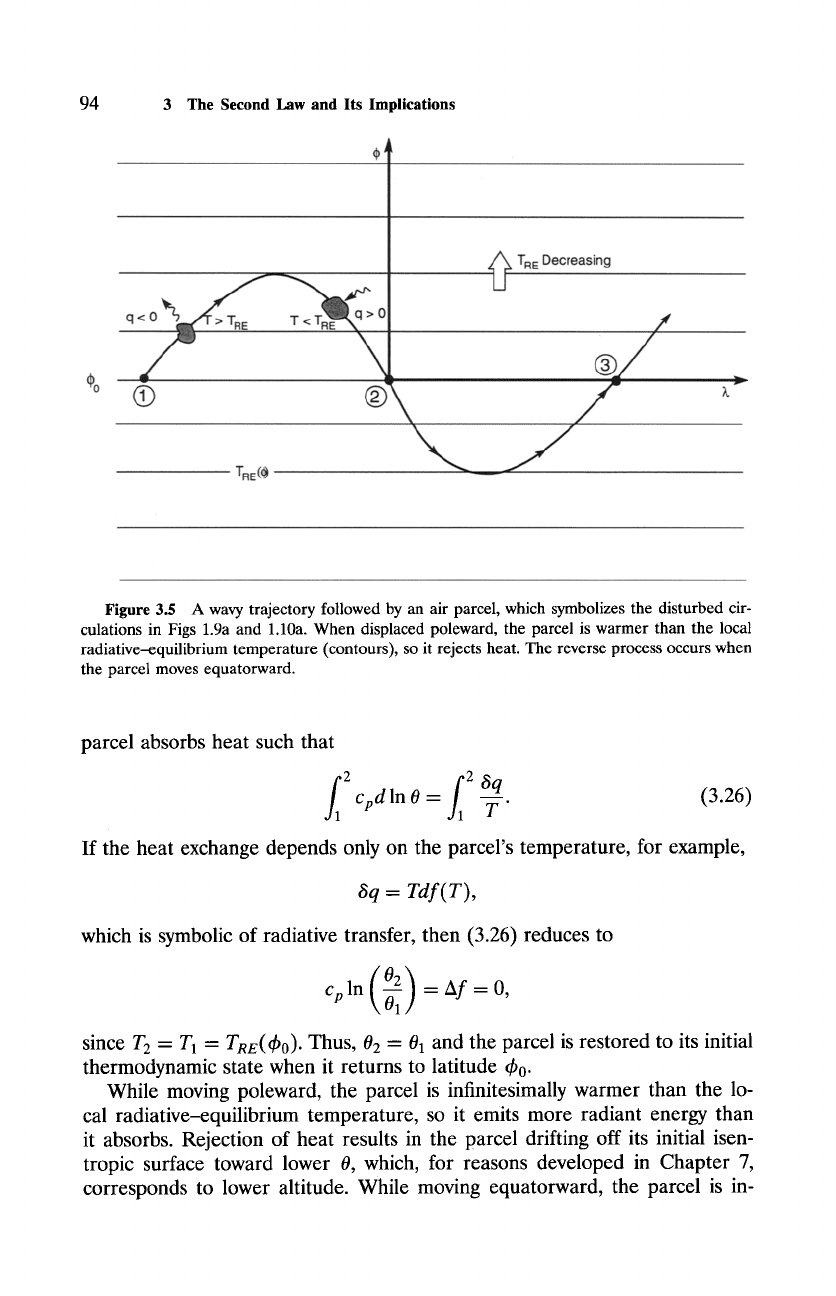
94
3
The Second Law and Its Implications
O TRE Decreasing
q<O
>TRE
T<TF
*o @ | /
TRE(~
Figure 3.5 A wavy trajectory followed by an air parcel, which symbolizes the disturbed cir-
culations in Figs 1.9a and 1.10a. When displaced poleward, the parcel is warmer than the local
radiative-equilibrium temperature (contours), so it rejects heat. The reverse process occurs when
the parcel moves equatorward.
parcel absorbs heat such that
f2 f26q
(3.26)
cpd
In
0 - -~--.
If the heat exchange depends only on the parcel's temperature, for example,
6q = Tdf ( T),
which is symbolic of radiative transfer, then (3.26) reduces to
cpln(O-~11)-
Af- 0,
since Te = 7"1 =
TRe(~bo).
Thus,
0 2 "- 01
and the parcel is restored to its initial
thermodynamic state when it returns to latitude ~b 0.
While moving poleward, the parcel is infinitesimally warmer than the lo-
cal radiative-equilibrium temperature, so it emits more radiant energy than
it absorbs. Rejection of heat results in the parcel drifting off its initial isen-
tropic surface toward lower 0, which, for reasons developed in Chapter 7,
corresponds to lower altitude. While moving equatorward, the parcel is in-
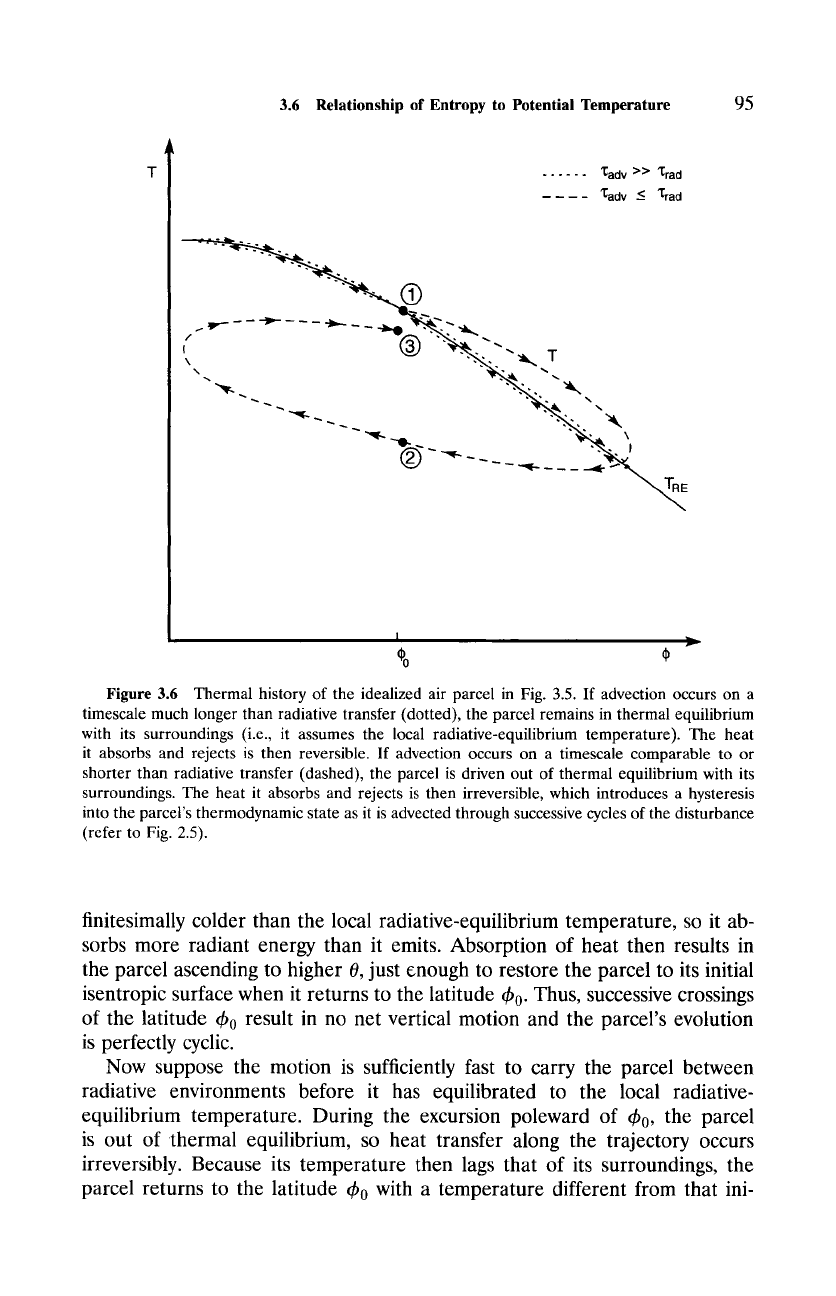
3.6 Relationship of Entropy to Potential Temperature
95
=lp,~ _ _ ~ _ _ _ ..~. - ~'~
9 .-...,.,..
.....
~ "" "~r-~ ........
...... 1;ad v >> "l:;ra d
"lad v < 1;ra d
"" \1
~E
Figure 3.6 Thermal history of the idealized air parcel in Fig. 3.5. If advection occurs on a
timescale much longer than radiative transfer (dotted), the parcel remains in thermal equilibrium
with its surroundings (i.e., it assumes the local radiative-equilibrium temperature). The heat
it absorbs and rejects is then reversible. If advection occurs on a timescale comparable to or
shorter than radiative transfer (dashed), the parcel is driven out of thermal equilibrium with its
surroundings. The heat it absorbs and rejects is then irreversible, which introduces a hysteresis
into the parcel's thermodynamic state as it is advected through successive cycles of the disturbance
(refer to Fig. 2.5).
finitesimally colder than the local radiative-equilibrium temperature, so it ab-
sorbs more radiant energy than it emits. Absorption of heat then results in
the parcel ascending to higher
O,
just enough to restore the parcel to its initial
isentropic surface when it returns to the latitude ~b 0. Thus, successive crossings
of the latitude ~b 0 result in no net vertical motion and the parcel's evolution
is perfectly cyclic.
Now suppose the motion is sufficiently fast to carry the parcel between
radiative environments before it has equilibrated to the local radiative-
equilibrium temperature. During the excursion poleward of ~b 0, the parcel
is out of thermal equilibrium, so heat transfer along the trajectory occurs
irreversibly. Because its temperature then lags that of its surroundings, the
parcel returns to the latitude ~b 0 with a temperature different from that ini-
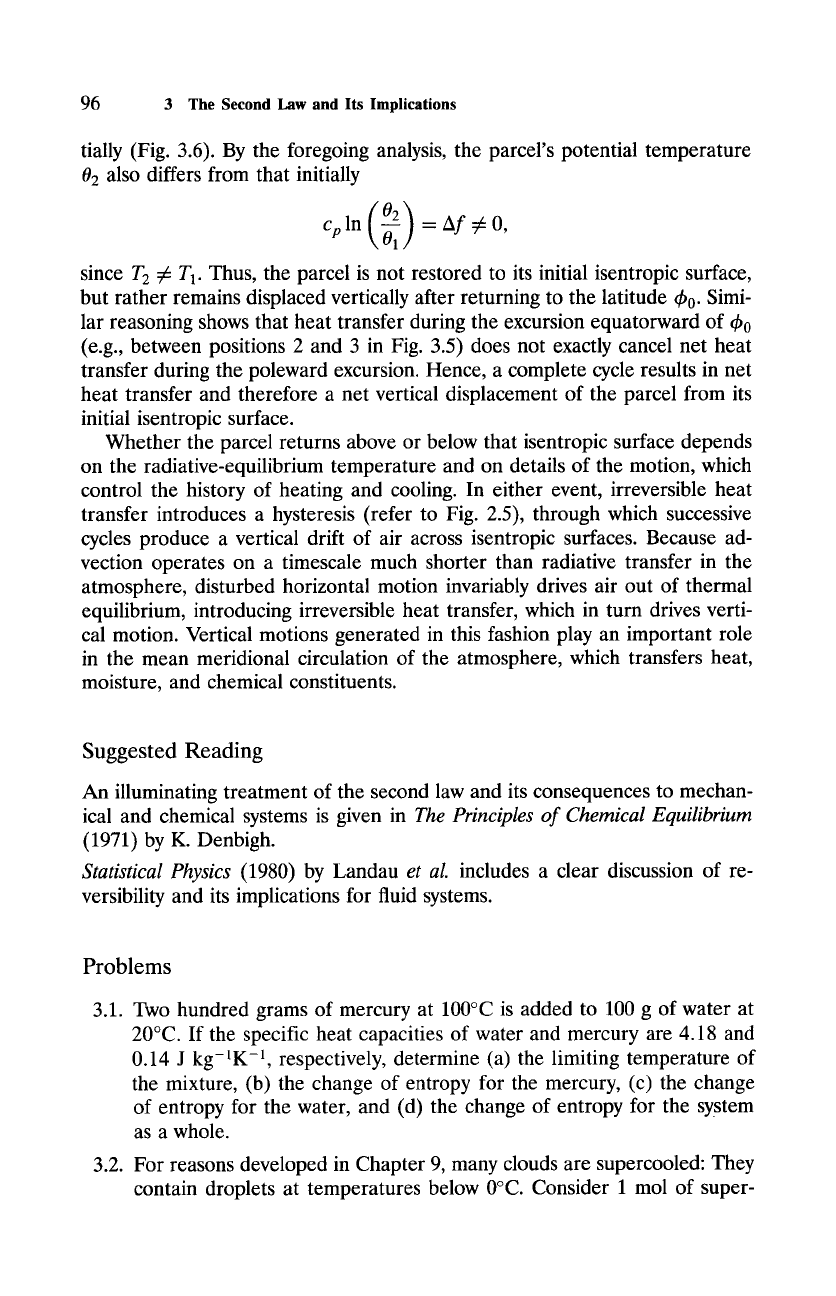
96 3
The Second Law and Its Implications
tially (Fig. 3.6). By the foregoing analysis, the parcel's potential temperature
02 also differs from that initially
Cp In (~)--Af #0,
since T2 ~ T1. Thus, the parcel is not restored to its initial isentropic surface,
but rather remains displaced vertically after returning to the latitude th0. Simi-
lar reasoning shows that heat transfer during the excursion equatorward of ~b0
(e.g., between positions 2 and 3 in Fig. 3.5) does not exactly cancel net heat
transfer during the poleward excursion. Hence, a complete cycle results in net
heat transfer and therefore a net vertical displacement of the parcel from its
initial isentropic surface.
Whether the parcel returns above or below that isentropic surface depends
on the radiative-equilibrium temperature and on details of the motion, which
control the history of heating and cooling. In either event, irreversible heat
transfer introduces a hysteresis (refer to Fig. 2.5), through which successive
cycles produce a vertical drift of air across isentropic surfaces. Because ad-
vection operates on a timescale much shorter than radiative transfer in the
atmosphere, disturbed horizontal motion invariably drives air out of thermal
equilibrium, introducing irreversible heat transfer, which in turn drives verti-
cal motion. Vertical motions generated in this fashion play an important role
in the mean meridional circulation of the atmosphere, which transfers heat,
moisture, and chemical constituents.
Suggested Reading
An illuminating treatment of the second law and its consequences to mechan-
ical and chemical systems is given in
The Principles of Chemical Equilibrium
(1971) by K. Denbigh.
Statistical Physics
(1980) by Landau
et al.
includes a clear discussion of re-
versibility and its implications for fluid systems.
Problems
3.1. Two hundred grams of mercury at 100~ is added to 100 g of water at
20~ If the specific heat capacities of water and mercury are 4.18 and
0.14 J kg-~K -1, respectively, determine (a) the limiting temperature of
the mixture, (b) the change of entropy for the mercury, (c) the change
of entropy for the water, and (d) the change of entropy for the system
as a whole.
3.2. For reasons developed in Chapter 9, many clouds are supercooled: They
contain droplets at temperatures below 0~ Consider 1 mol of super-
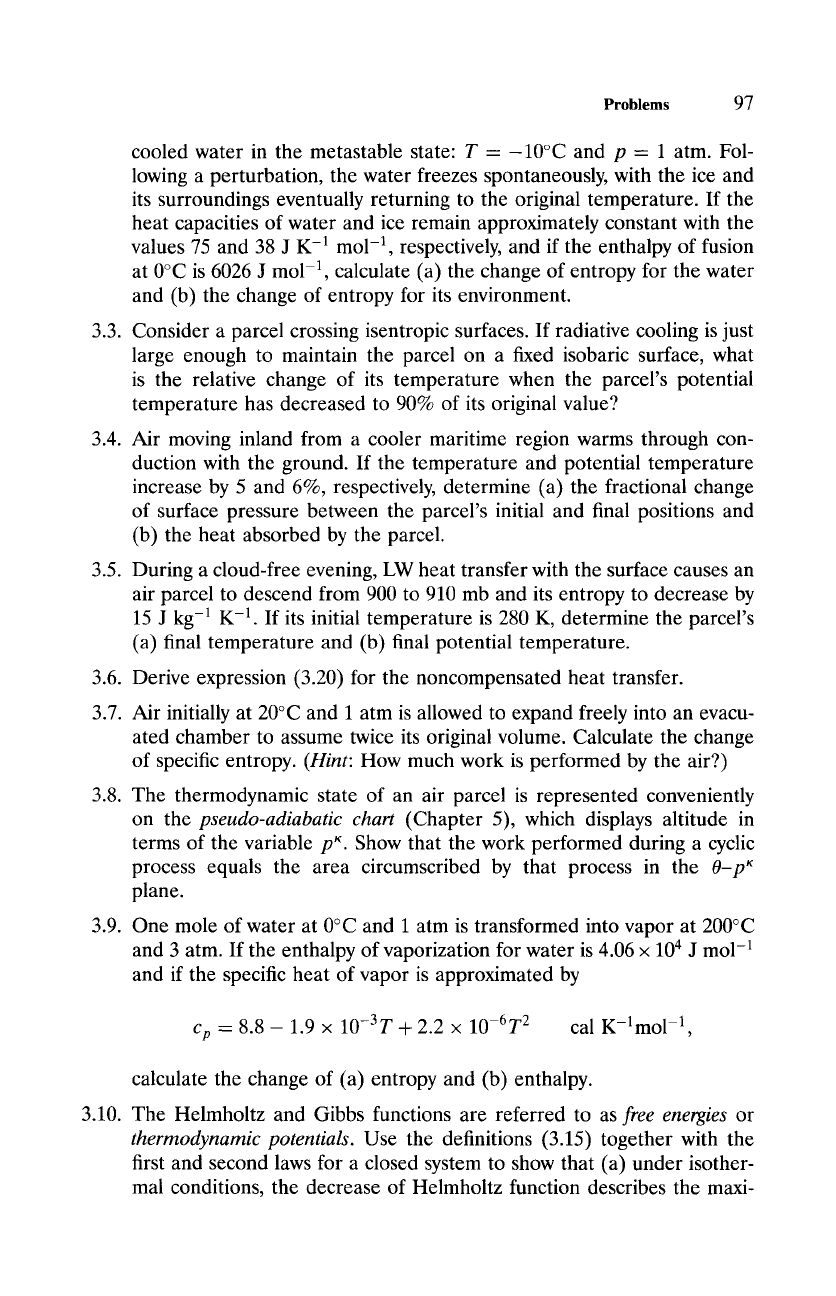
Problems
97
3.3.
3.4.
3.5.
3.6.
3.7.
3.8.
3.9.
cooled water in the metastable state: T = -10~ and p --- 1 atm. Fol-
lowing a perturbation, the water freezes spontaneously, with the ice and
its surroundings eventually returning to the original temperature. If the
heat capacities of water and ice remain approximately constant with the
values 75 and 38 J K -a mo1-1, respectively, and if the enthalpy of fusion
at 0~ is 6026 J mo1-1, calculate (a) the change of entropy for the water
and (b) the change of entropy for its environment.
Consider a parcel crossing isentropic surfaces. If radiative cooling is just
large enough to maintain the parcel on a fixed isobaric surface, what
is the relative change of its temperature when the parcel's potential
temperature has decreased to 90% of its original value?
Air moving inland from a cooler maritime region warms through con-
duction with the ground. If the temperature and potential temperature
increase by 5 and 6%, respectively, determine (a) the fractional change
of surface pressure between the parcel's initial and final positions and
(b) the heat absorbed by the parcel.
During a cloud-flee evening, LW heat transfer with the surface causes an
air parcel to descend from 900 to 910 mb and its entropy to decrease by
15 J kg -1 K -1. If its initial temperature is 280 K, determine the parcel's
(a) final temperature and (b) final potential temperature.
Derive expression (3.20) for the noncompensated heat transfer.
Air initially at 20~ and 1 atm is allowed to expand freely into an evacu-
ated chamber to assume twice its original volume. Calculate the change
of specific entropy.
(Hint:
How much work is performed by the air?)
The thermodynamic state of an air parcel is represented conveniently
on the
pseudo-adiabatic chart
(Chapter 5), which displays altitude in
terms of the variable pK. Show that the work performed during a cyclic
process equals the area circumscribed by that process in the
O-p ~
plane.
One mole of water at 0~ and 1 atm is transformed into vapor at 200~
and 3 atm. If the enthalpy of vaporization for water is 4.06
• 10 4
J mo1-1
and if the specific heat of vapor is approximated by
Cp
= 8.8- 1.9
• 10-3T
-t- 2.2
• 10-6T 2
cal
K -lmO1-1,
calculate the change of (a) entropy and (b) enthalpy.
3.10. The Helmholtz and Gibbs functions are referred to as
free energies
or
thermodynamic potentials.
Use the definitions (3.15) together with the
first and second laws for a closed system to show that (a) under isother-
mal conditions, the decrease of Helmholtz function describes the maxi-
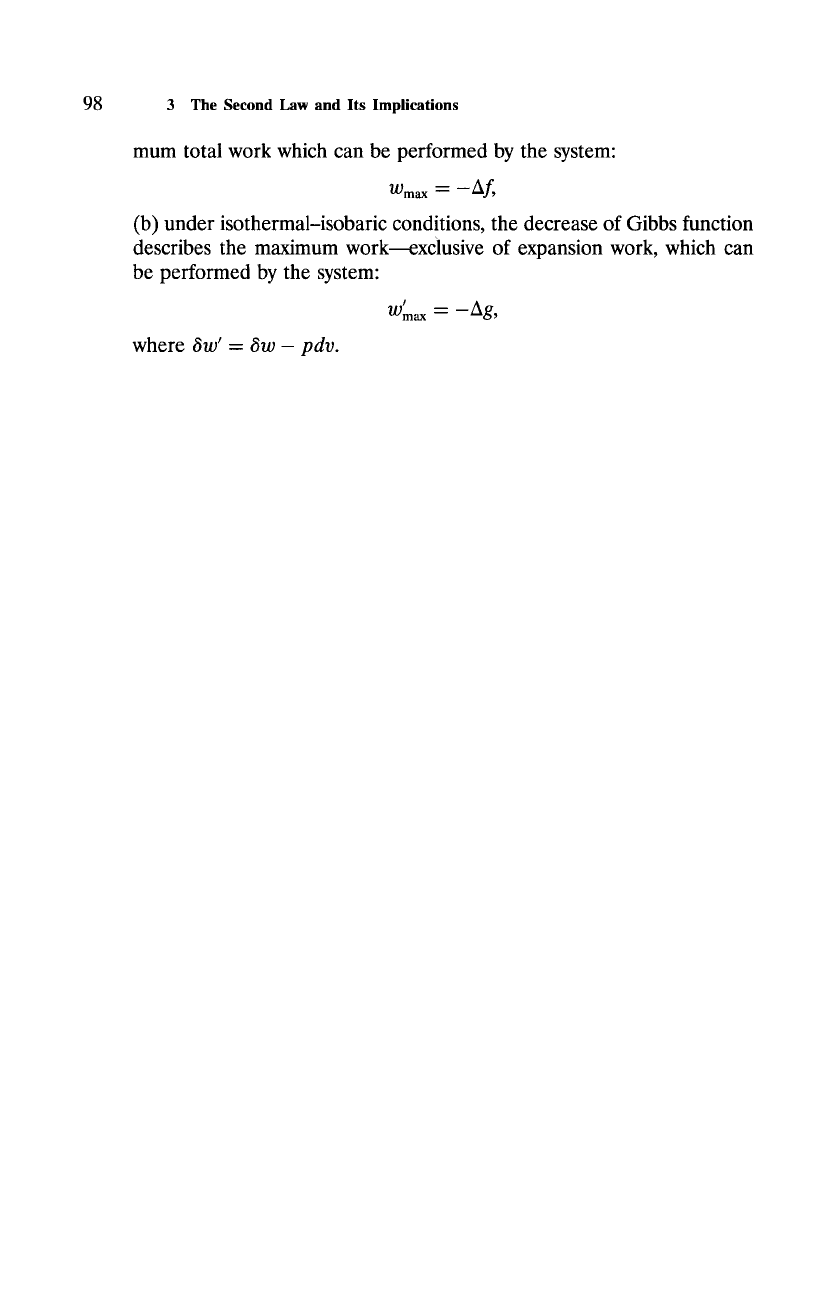
98
3
The Second
Law and
Its Implications
mum total work which can be performed by the system:
Wma x ~ --Af,
(b)
under isothermal-isobaric conditions, the decrease of Gibbs function
describes the maximum work--exdusive of expansion work, which can
be performed by the system:
' - -Ag,
Wmax
where 8w' = 8w- pdv.
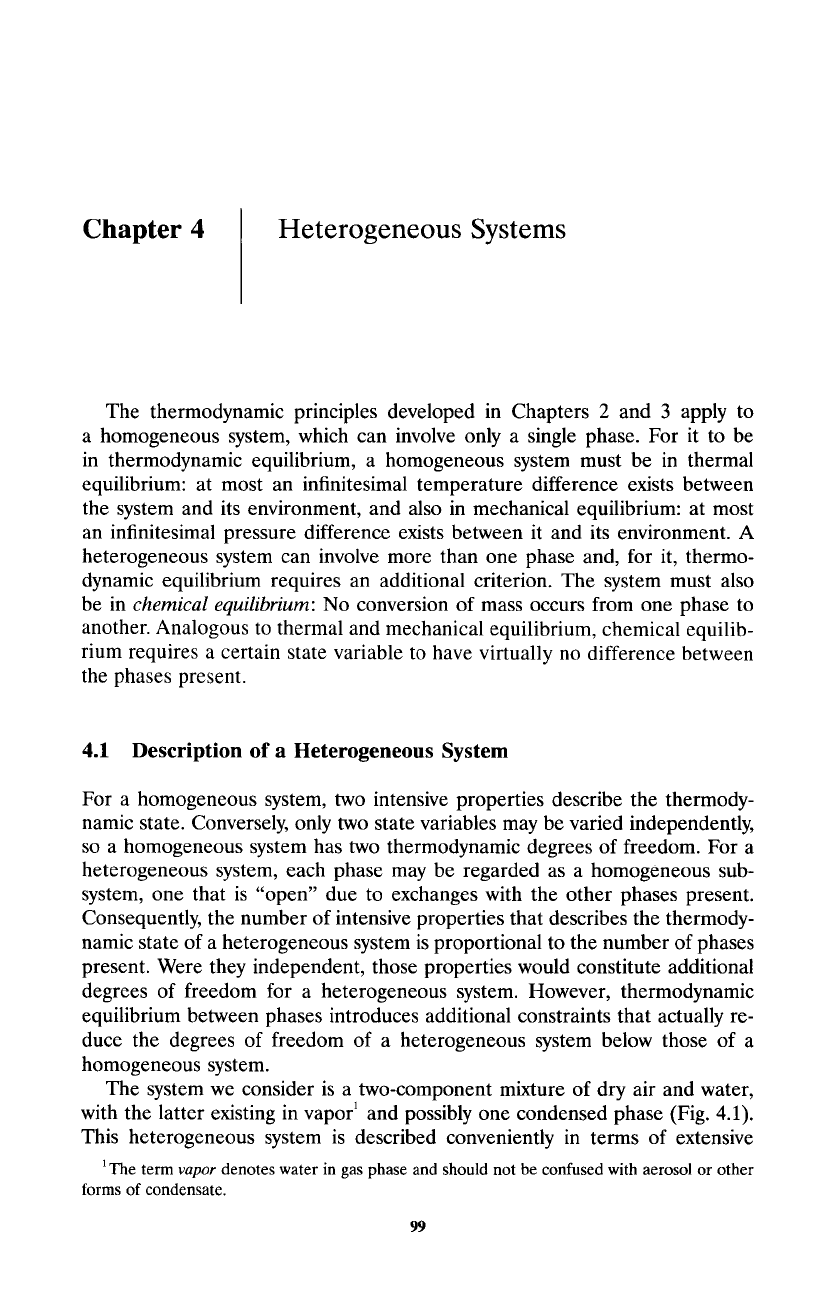
Chapter 4 Heterogeneous Systems
The thermodynamic principles developed in Chapters 2 and 3 apply to
a homogeneous system, which can involve only a single phase. For it to be
in thermodynamic equilibrium, a homogeneous system must be in thermal
equilibrium: at most an infinitesimal temperature difference exists between
the system and its environment, and also in mechanical equilibrium: at most
an infinitesimal pressure difference exists between it and its environment. A
heterogeneous system can involve more than one phase and, for it, thermo-
dynamic equilibrium requires an additional criterion. The system must also
be in
chemical equilibrium:
No conversion of mass occurs from one phase to
another. Analogous to thermal and mechanical equilibrium, chemical equilib-
rium requires a certain state variable to have virtually no difference between
the phases present.
4.1 Description of a Heterogeneous System
For a homogeneous system, two intensive properties describe the thermody-
namic state. Conversely, only two state variables may be varied independently,
so a homogeneous system has two thermodynamic degrees of freedom. For a
heterogeneous system, each phase may be regarded as a homogeneous sub-
system, one that is "open" due to exchanges with the other phases present.
Consequently, the number of intensive properties that describes the thermody-
namic state of a heterogeneous system is proportional to the number of phases
present. Were they independent, those properties would constitute additional
degrees of freedom for a heterogeneous system. However, thermodynamic
equilibrium between phases introduces additional constraints that actually re-
duce the degrees of freedom of a heterogeneous system below those of a
homogeneous system.
The system we consider is a two-component mixture of dry air and water,
with the latter existing
in
vapor I and possibly one condensed phase (Fig. 4.1).
This heterogeneous system is described conveniently in terms of extensive
1The
term vapor denotes water in gas phase and should not be confused with aerosol or other
forms of condensate.
99
